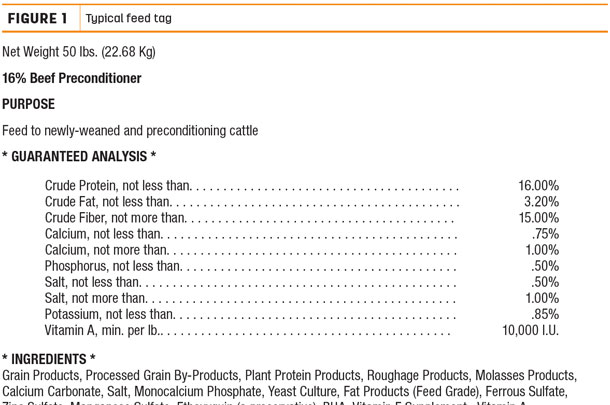Labels are a means of ensuring the products contain what they are supposed to, and it helps ensure the producer gets what he pays for. States have regulatory agencies that monitor labeling and packaging products to accomplish exactly that: making sure the products meet what is on the label. Figure 1 is an example tag for a typical cattle feed.
Click here or on the image above to view it at full size in a new window.
Other variations exist on tags due to species, medications, additives, usage, etc., so this discussion is limited to the basics. Also, different states have different guidelines for the information they require, but most of the basics are the same.
Net weight
This designation tells you what the total weight of the product should be. Per the example, you should be receiving a minimum of 50 pounds of feed in the bag you just purchased. The bag itself will normally weigh about one-half to 1 pound.
Accurate weights of bags and contents to produce net weight has, at times, been challenging for feed manufacturers, although many more accurate weighting systems exist. This is closely monitored by regulatory agencies, so in most situations, it should be fairly accurate. If feeds are delivered in bulk, a weigh ticket, bill of lading and tag copy should accompany the delivery.
Product name
Most of the time this is simply a means of identifying the product. Lots of attention-grabbing product names are out there, and some products have developed significant name recognition.
Naming of a given product is more related to marketing than the actual content of the product. Naming is important to help differentiate one product from another since many products are very similar.
Purpose statement
The purpose statement provides a brief description of the product use. In many cases, products are used for many different programs or species other than what the purpose calls for. This simply states what the manufacturer has intended with this product.
Medication statement
In many cases, products contain some type of medication such as Rumensin, chlortetracycline, etc. The statement gives the level of the active ingredient and the level included in the product. Farther down the label, information is provided that tells how much should be fed to provide the necessary amount of drug. Information is also included that indicates which species should not receive the product because of the drug inclusion.
Guaranteed analysis
The guaranteed analysis provides the nutritional information for the product and indicates minimums and maximums of certain nutrients. State regulatory agencies specify the nutrients to be guaranteed. In other words, the manufacturer must include a minimum amount of information in this area.
In many cases, a feed company will include more than the nutrients required to help show the product is of higher value. The guaranteed analysis does not give you adequate information to completely determine product acceptability in your program. It does not provide dry matter (the exception is liquid feeds) or energy information and may or may not include detailed mineral and vitamin specifications.
When making feed decisions, the producer should request a nutrient profile from the manufacturer to obtain the necessary critical information. The guaranteed analysis does not provide an accurate indication of the value of the product. Given a set of tag guarantees, endless combinations of ingredients can be combined to meet these specifications at a wide range of costs.
Ingredient list
The ingredient list provides a list of the ingredients used in the manufacture of the product. This may be a list of actual ingredients (corn, cottonseed meal, etc.), which are included in the product. Often feed companies will use “collective terms” which group ingredients into broader categories. For instance, corn or milo would fall into the “grain products” category. Soybean meal or cottonseed meal will be included in “plant protein products.”
“Processed grain byproducts” includes products such as wheat midds or rice bran. This gives the feed company more flexibility to modify the formula to maintain their profit margins. Minerals and vitamins are specified individually. Ingredients should be included in the order of highest to lowest inclusion level.
Feeding directions
Feeding directions indicate how the product is to be fed to produce the results desired. These directions can range from specific to nonspecific. Generally, feeding directions provide common-sense information which you would normally know anyway. Directions for products including medications or additives may be considerably more extensive.
Caution statements
The caution statement specifies conditions where you must be cautious. Many of these statements are mandated by state and federal regulatory agencies. One example is the selenium statement. Other statements include warnings regarding high copper inclusion rates and not to feed products of this nature to sheep.
This is where warning statements appear regarding the inclusion of medications such as Bovatec or Rumensin and “not to feed these to horses.”
Manufacturing statement
This statement indicates who manufactures the product or who is responsible for guarantees made on the tag. This may or may not be the actual manufacturing facility. Often the product is made by one entity and sold by another. This statement provides contact information and how to reach the responsible party.
Feed tags provide much-needed information, especially that which will protect the consumer. It is important to learn how to read these labels and how to understand the information contained therein to properly evaluate the product and properly use what is contained within. ![]()
Dr. Steve Blezinger is a nutritional and management consultant with an office in Sulphur Springs, Texas. He can be reached at 667 CR 4711, Sulphur Springs, TX 75482, or by phone at (903) 352-3475.

-
Stephen Blezinger
- Management and Nutritional Consultant
- Reveille Livestock Concepts
- Email Stephen Blezinger







